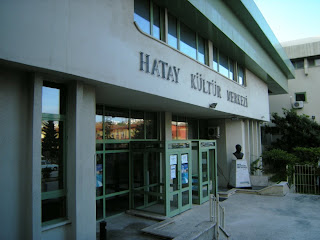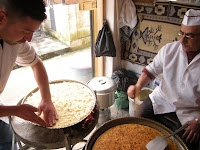
17 Nisan 2009, Cuma, 20.00 – Hatay Kültür Merkezi, Hatay, Türkiye
Ekip Adana'dan çıkmadan, sabahın erken saatlerinde Antakya'dan gelecek haberi bekledi. Sel baskınları yüzünden Antakya'daki oyununun, oynanıp oynanmaması söz konusuydu. Antakya'da hayatın normale döndüğü öğrenildikten sonra ekip yola koyuldu.
Öğlen Antakya'ya varıldı, Mozaik Otel'e eşyalar bırakıldı ve ünlü Antakya lezzetleri için Uzun Çarşı'ya girildi. Ekip, Uzun Çarşı'da önce kasaplardan birinde tepsi ve kağıt kebabı yedi. Uzun 

Yemekten sonra Hatay Kültür Merkezi'ne malzemeler indirilip hazırlık yapılmaya başlandı. Hatay Kültür Merkezi'nin salonunun ölçüleri oldukça ideal. Sofitası, izleyici kapasitesi, sahne derinliği gayet iyi. Fakat malzeme indirecek yeri yok,. Malzeme çok zor bir yoldan sahneye ulaştırılıyor. Soyunma odaları çok bakımsız ve ihtiyacı karşılamıyor. Sahnenin ahşap zemini çok gürültü yapıyor. Salonun ciddi bir ses izolasyonu sorunu var. Aşağı kattaki çalışma odalarındaki ses, sahneye geliyor. Tarsus'taki gibi salonda sürekli faaliyet gösteren bir yerleşik sanat kurumu ya da sanat yöneticisi yok. Bütün salonda bir tane görevli var.
Oyunda salonun yarısından daha az seyirci vardı. Ama oyun boyunca seyircinin tepkisi hiç azalmadı. Oyundan sonra seyircinin çoğu fuayede sohbet etmek için kaldı. Seyirci ile birçok röportaj yapıldı. Oyundan sonra ekibi, Antakya'da tanıştığı dostları, Kuzeytepe'deki Maho Aile Kebap Salonu'na götürdü. Ekip, Antakya'dan ayrılmadan şehrin farklı lezzetlerini de tatmış oldu.
17 April 2009, Friday, 20.00 – Hatay Culture Center, Hatay, Turkey
Early in the morning, before leaving Adana, the team waited for the news from Antakya. Because of the flood in Antakya, there was a possibility of cancellation of the play. When they learned that the life was normalized in the city, they went on the way.


After the meal the set-up started in Hatay Culture Center. The dimensions of the hall are very ideal. The celling of the stage, audience capacity, depth of the stage are fairly enough. But there is no place for loading. The equipments can be taken to the stage from a very difficult way. The dressing rooms are very poor looking,and doesn't fulfill the needs. The wooden floor of the stage makes a lot of noise. There is a big sound isolation problem. The noises from the exercise rooms downstairs come to the stage. As in Tarsus,
There isn't any resident artistic company, or artistic director. There is only one responsible person fro everything in the whole building.
The audience were less then the half. But the reaction of the audience never declined throughout the play. Many of the audience stayed after the play to have a conversation. Many interviews were made with the audience. Friends who were met in Antakya, took the the team to Maho Kebab House in Kuzeytepe. Thus, the team had experienced the various tastes of Antakya before they leave.





Hiç yorum yok:
Yorum Gönder